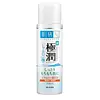What's inside
What's inside
 Key Ingredients
Key Ingredients

 Benefits
Benefits

 Concerns
Concerns

No concerns
 Ingredients Side-by-side
Ingredients Side-by-side

Water
Skin ConditioningGlycerin
HumectantSodium Cocoyl Glycinate
CleansingButylene Glycol
HumectantHydroxypropyl Starch Phosphate
Cocamidopropyl Betaine
CleansingPEG-400
Emulsion StabilisingDecyl Glucoside
CleansingPotassium Cocoyl Glycinate
Sodium Stearoyl Glutamate
CleansingGlyceryl Stearate Se
EmulsifyingCitric Acid
BufferingLauric Acid
CleansingStearic Acid
CleansingDisodium Cocoyl Glutamate
CleansingPhenoxyethanol
PreservativeHexylglycerin
HumectantSodium Cocoyl Glutamate
CleansingBHT
AntioxidantDisodium EDTA
Hydroxypropyl Methylcellulose
Emulsion StabilisingHydroxypropyltrimonium Hyaluronate
Sodium Acetylated Hyaluronate
HumectantTocopherol
AntioxidantWater, Glycerin, Sodium Cocoyl Glycinate, Butylene Glycol, Hydroxypropyl Starch Phosphate, Cocamidopropyl Betaine, PEG-400, Decyl Glucoside, Potassium Cocoyl Glycinate, Sodium Stearoyl Glutamate, Glyceryl Stearate Se, Citric Acid, Lauric Acid, Stearic Acid, Disodium Cocoyl Glutamate, Phenoxyethanol, Hexylglycerin, Sodium Cocoyl Glutamate, BHT, Disodium EDTA, Hydroxypropyl Methylcellulose, Hydroxypropyltrimonium Hyaluronate, Sodium Acetylated Hyaluronate, Tocopherol
Water
Skin ConditioningButylene Glycol
HumectantPentylene Glycol
Skin ConditioningDipropylene Glycol
HumectantPPG-10 Methyl Glucose Ether
Skin ConditioningDiglycerin
HumectantPhenoxyethanol
PreservativeDisodium Succinate
MaskingSodium Hyaluronate
HumectantDisodium EDTA
Hydroxyethylcellulose
Emulsion StabilisingSuccinic Acid
BufferingSodium Acetylated Hyaluronate
HumectantHydrolyzed Hyaluronic Acid
HumectantLactococcus/Hyaluronic Acid Ferment Filtrate
Water, Butylene Glycol, Pentylene Glycol, Dipropylene Glycol, PPG-10 Methyl Glucose Ether, Diglycerin, Phenoxyethanol, Disodium Succinate, Sodium Hyaluronate, Disodium EDTA, Hydroxyethylcellulose, Succinic Acid, Sodium Acetylated Hyaluronate, Hydrolyzed Hyaluronic Acid, Lactococcus/Hyaluronic Acid Ferment Filtrate
Ingredients Explained
These ingredients are found in both products.
Ingredients higher up in an ingredient list are typically present in a larger amount.
Butylene Glycol (or BG) is used within cosmetic products for a few different reasons:
Overall, Butylene Glycol is a safe and well-rounded ingredient that works well with other ingredients.
Though this ingredient works well with most skin types, some people with sensitive skin may experience a reaction such as allergic rashes, closed comedones, or itchiness.
Learn more about Butylene GlycolDisodium EDTA plays a role in making products more stable by aiding other preservatives.
It is a chelating agent, meaning it neutralizes metal ions that may be found in a product.
Disodium EDTA is a salt of edetic acid and is found to be safe in cosmetic ingredients.
Learn more about Disodium EDTAPhenoxyethanol is a preservative that has germicide, antimicrobial, and aromatic properties. Studies show that phenoxyethanol can prevent microbial growth. By itself, it has a scent that is similar to that of a rose.
It's often used in formulations along with Caprylyl Glycol to preserve the shelf life of products.
Sodium Acetylated Hyaluronate is a type of Hyaluronic Acid.
Hyaluronic Acids help moisturize, soothe, and protect the skin.
Read about common types of Hyaluronic Acid here:
Sodium Hyaluronate
Hydrolyzed Hyaluronic Acid
Hyaluronic Acid
Water. It's the most common cosmetic ingredient of all. You'll usually see it at the top of ingredient lists, meaning that it makes up the largest part of the product.
So why is it so popular? Water most often acts as a solvent - this means that it helps dissolve other ingredients into the formulation.
You'll also recognize water as that liquid we all need to stay alive. If you see this, drink a glass of water. Stay hydrated!
Learn more about Water